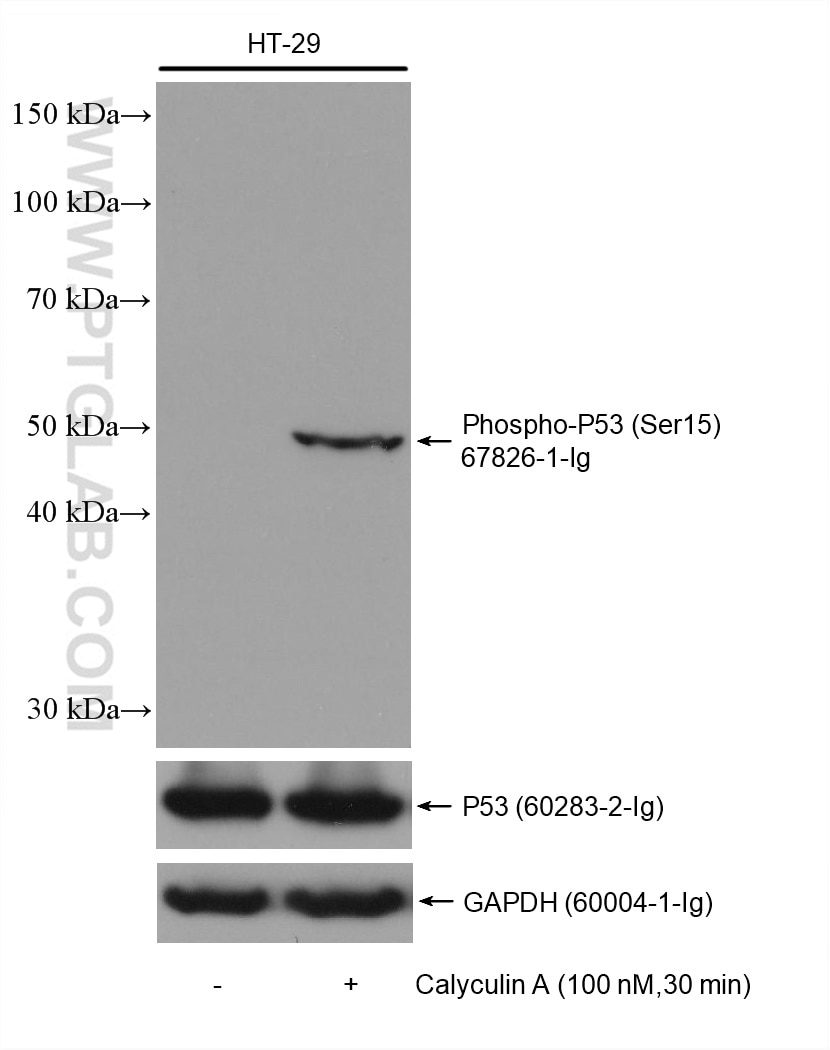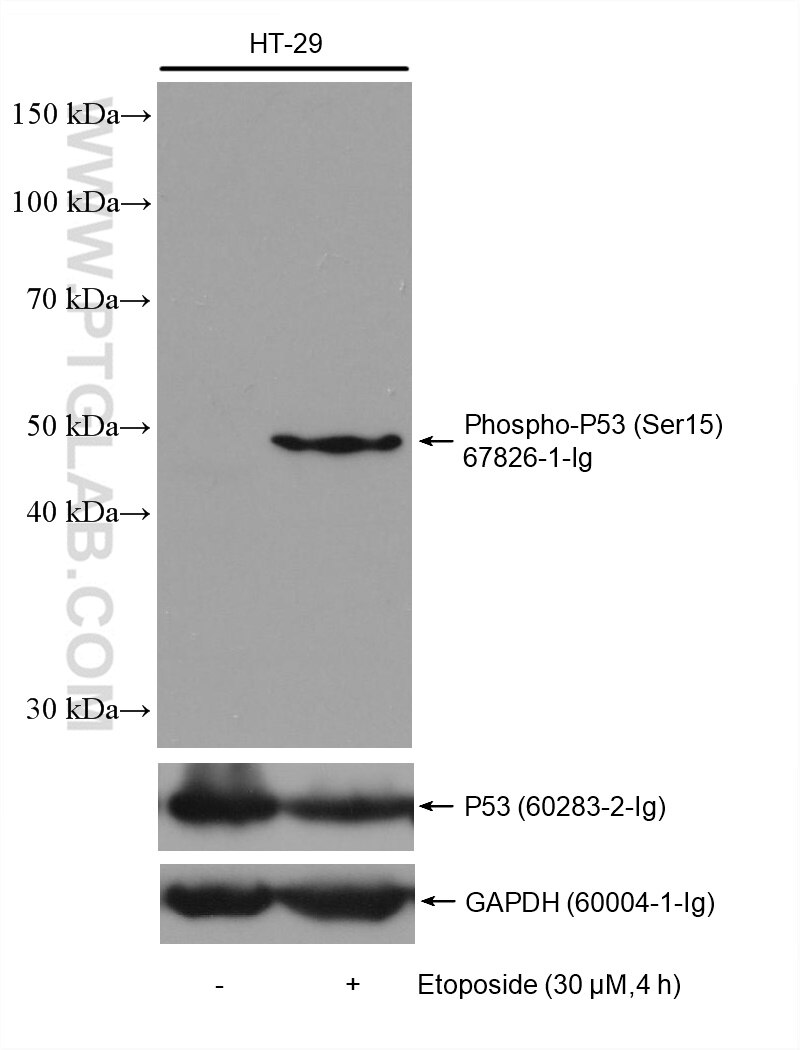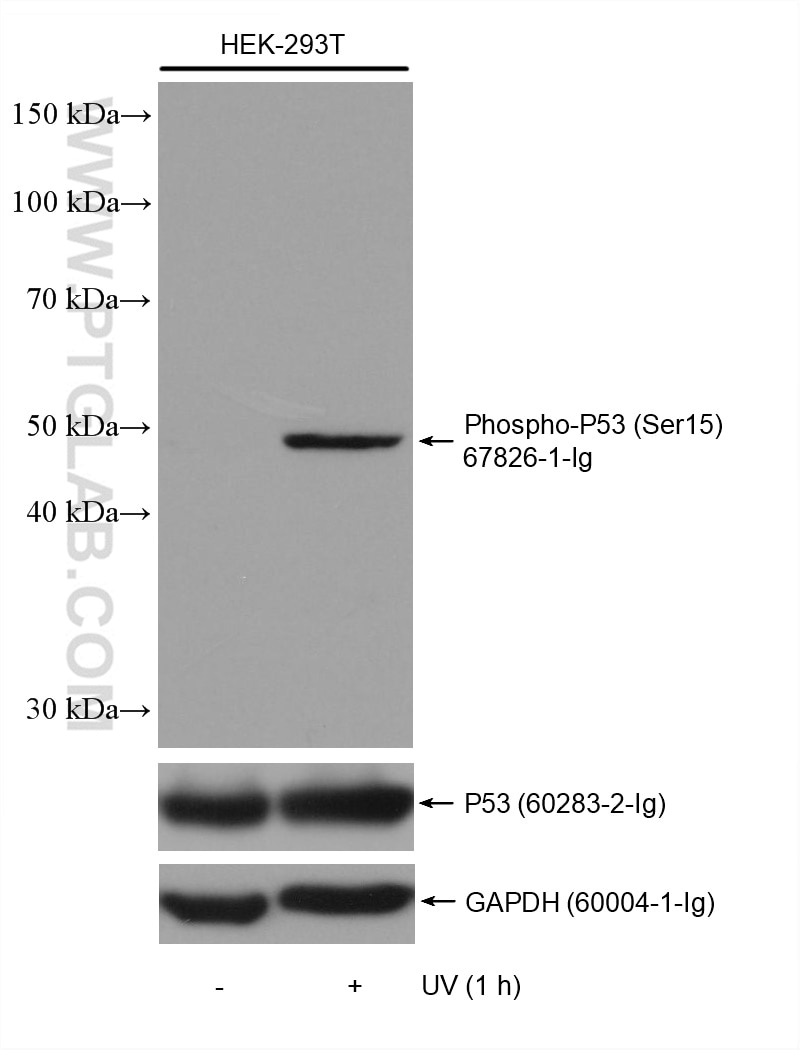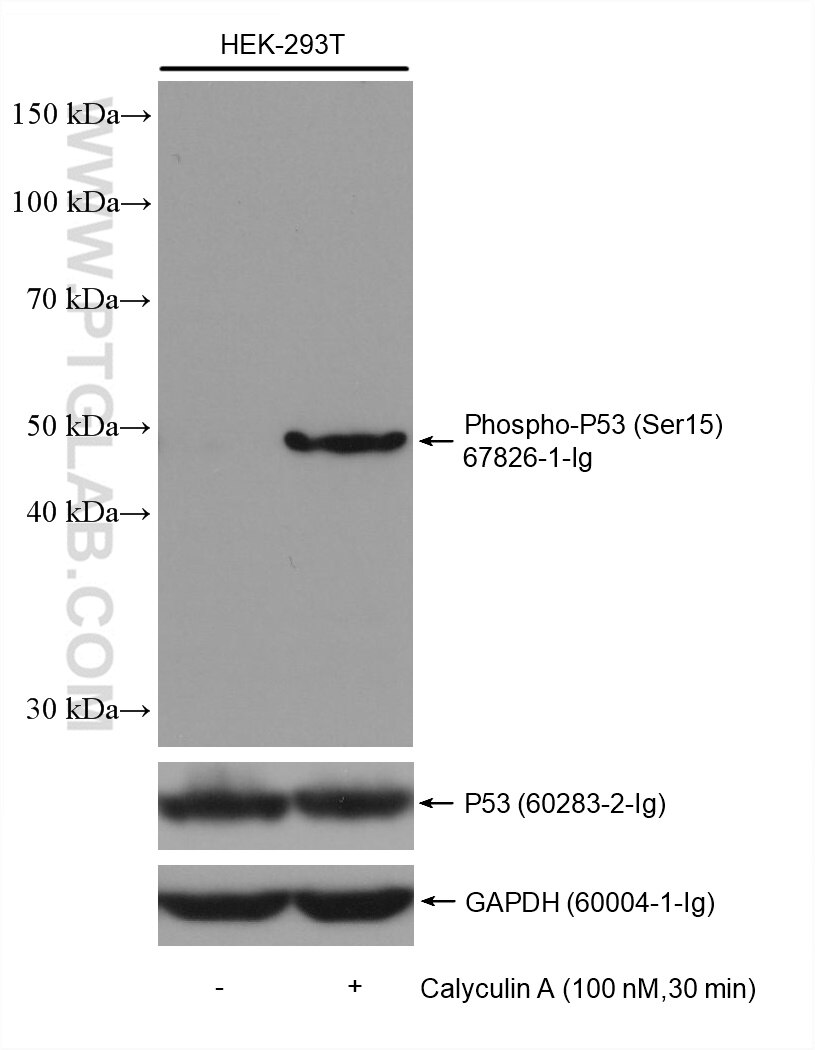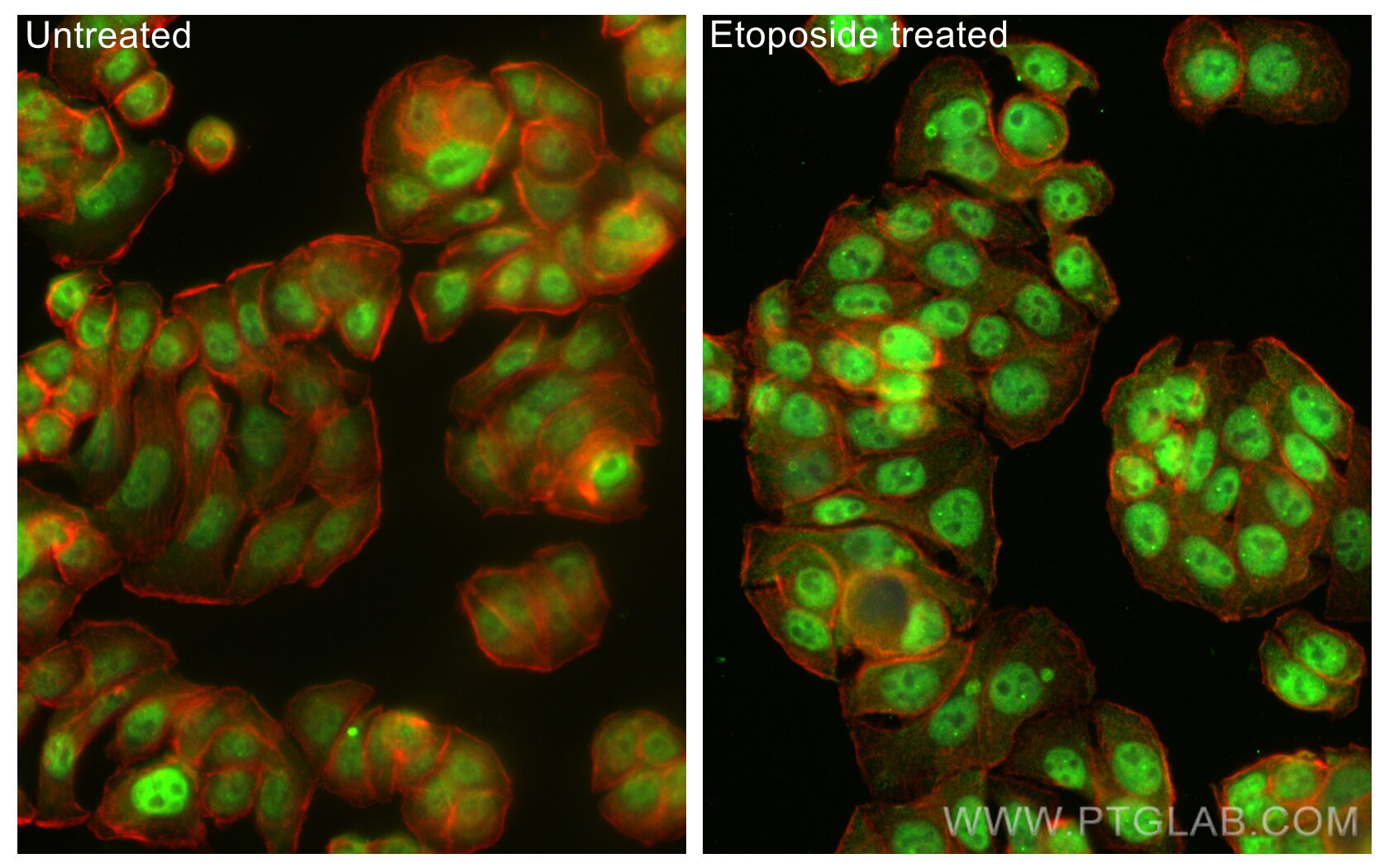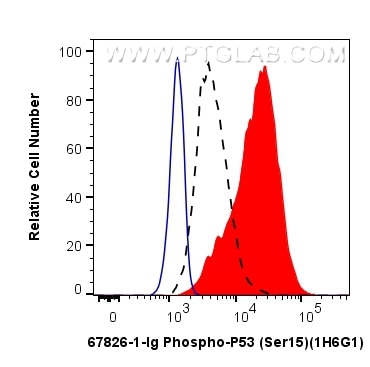Phospho-P53 (Ser15) Monoklonaler Antikörper
Phospho-P53 (Ser15) Monoklonal Antikörper für WB, IF/ICC, FC (Intra), ELISA
Wirt / Isotyp
Maus / IgG1
Getestete Reaktivität
human und mehr (3)
Anwendung
WB, IHC, IF/ICC, FC (Intra), ELISA
Konjugation
Unkonjugiert
CloneNo.
1H6G1
Kat-Nr. : 67826-1-Ig
Synonyme
Geprüfte Anwendungen
| Erfolgreiche Detektion in WB | mit Calyculin A behandelte HT-29-Zellen, Mit Calyculin A behandelte HEK-293-Zellen, HEK-293-Zellen, HEK-293T-Zellen, HT-29-Zellen, Mit UV behandelte HEK-293T-Zellen |
| Erfolgreiche Detektion in IF/ICC | mit Etoposid behandelte HT-29-Zellen |
| Erfolgreiche Detektion in FC (Intra) | UV treated HT-29 cells |
Empfohlene Verdünnung
| Anwendung | Verdünnung |
|---|---|
| Western Blot (WB) | WB : 1:1000-1:6000 |
| Immunfluoreszenz (IF)/ICC | IF/ICC : 1:400-1:1600 |
| Durchflusszytometrie (FC) (INTRA) | FC (INTRA) : 0.13 ug per 10^6 cells in a 100 µl suspension |
| It is recommended that this reagent should be titrated in each testing system to obtain optimal results. | |
| Sample-dependent, check data in validation data gallery | |
Veröffentlichte Anwendungen
| WB | See 18 publications below |
| IHC | See 2 publications below |
| IF | See 2 publications below |
Produktinformation
67826-1-Ig bindet in WB, IHC, IF/ICC, FC (Intra), ELISA Phospho-P53 (Ser15) und zeigt Reaktivität mit human
| Getestete Reaktivität | human |
| In Publikationen genannte Reaktivität | human, Hausschwein, Maus, Ratte |
| Wirt / Isotyp | Maus / IgG1 |
| Klonalität | Monoklonal |
| Typ | Antikörper |
| Immunogen | Peptid |
| Vollständiger Name | tumor protein p53 |
| Berechnetes Molekulargewicht | 44 kDa |
| Beobachtetes Molekulargewicht | 53 kDa |
| GenBank-Zugangsnummer | BC003596 |
| Gene symbol | P53 |
| Gene ID (NCBI) | 7157 |
| Konjugation | Unkonjugiert |
| Form | Liquid |
| Reinigungsmethode | Protein-G-Reinigung |
| Lagerungspuffer | PBS with 0.02% sodium azide and 50% glycerol |
| Lagerungsbedingungen | Bei -20°C lagern. Nach dem Versand ein Jahr lang stabil Aliquotieren ist bei -20oC Lagerung nicht notwendig. 20ul Größen enthalten 0,1% BSA. |
Hintergrundinformationen
TP53, also known as P53 and NY-CO-13, belongs to the p53 family and has 9 isoforms. In SDS-Page, the observed molecular weight is about 53 kDa. TP53 acts as a tumor suppressor in many tumor types, including growth arrest or apoptosis depending on the physiological circumstances and cell types. It is involved in cell cycle regulation as a trans-activator that acts to negatively regulate cell division by controlling a set of genes required for this process. TP53 Localizes in the nucleus in most cells but found in the cytoplasm in some cells. (PMID: 26166714; PMID: 25225161)
Protokolle
| PRODUKTSPEZIFISCHE PROTOKOLLE | |
|---|---|
| WB protocol for Phospho-P53 (Ser15) antibody 67826-1-Ig | Protokoll herunterladen |
| IF protocol for Phospho-P53 (Ser15) antibody 67826-1-Ig | Protokoll herunterladen |
| STANDARD-PROTOKOLLE | |
|---|---|
| Klicken Sie hier, um unsere Standardprotokolle anzuzeigen |
Publikationen
| Species | Application | Title |
|---|---|---|
Phytomedicine MaiJiTong granule attenuates atherosclerosis by reducing ferroptosis via activating STAT6-mediated inhibition of DMT1 and SOCS1/p53 pathways in LDLR-/- mice | ||
J Virol Hepatitis B doubly spliced protein (HBDSP) promotes hepatocellular carcinoma cell apoptosis via ETS1/GATA2/YY1-mediated p53 transcription | ||
Food Chem Toxicol Enhanced glutathione production protects against zearalenone-induced oxidative stress and ferroptosis in female reproductive system | ||
Front Pharmacol A New Chalcone Derivative C49 Reverses Doxorubicin Resistance in MCF-7/DOX Cells by Inhibiting P-Glycoprotein Expression. | ||
Toxicol Lett The mechanism of rh-endostatin-induced cardiotoxicity and its protection by dihydromyricetin[in vivo/in vitro, C57BL/6 mice, AC16 and hiPSC-CMs] | ||
World Neurosurg N-acetylserotonin protects rat nucleus pulposus cells against oxidative stress injury by activating the PI3K/AKT signaling pathway |
